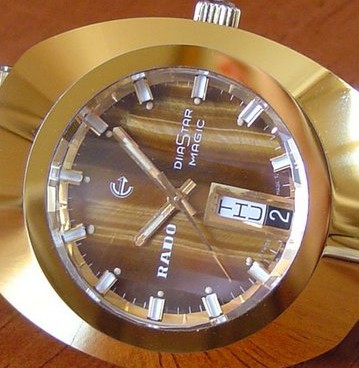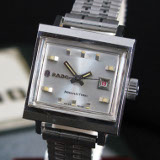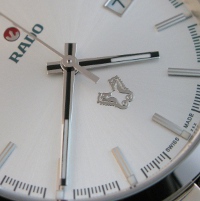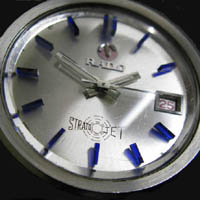RADO Watches

Brand: Rado
Model: Manhattan
Ref.: 11815
Issued Ca. 1968
Case: Stainless steel with integral snap-on back/movement cradle
Crystal: Acrylic with Rado logo at center
Bracelet: Original NSA with Rado clasp, reference 0571
Movement: Rado Cal 1859 (A Schild 1901), 17 jewels, gilt
Description: This is one of the original series of Manhattan models issued by Rado in the mid-1960s and produced until 1973. This example has the deep recessed case back which holds the movement in place, snaps to the bezel, and is protected by a large plastic crystal. The crystal envelops the case back and is rendered water-tight by close contact with an o-ring gasket. Photos of this and more information on the Rado Manhattan series can be found in this article. Please note that some later examples of the Manhattan have been seen which employ a simple snap-back which is not the water-resistant version pictured here.
This example features the relatively common silver dial with wedge markers. The original bracelet, a flat-clasp model made by Novavit S.A., is present.
This page from a 1972 Japanese catalog shows this watch and bracelet combination.
The case front shows little wear and the back has some minor marks. The movement, stamped A.S. 1901 and 1859 (see EquationofTime.com's Rado Forum for more on this) is perfectly preserved and keeping accurate time; the day/date mechanisms change properly. The movement is clearly intended for the US market as it is marked with the import code UOR and "unadjusted' on the rotor.
Photos:





This watch is not available for sale.
Note: More specific information pertaining to the manufacture/issue date of this watch is welcome.
Text and images © C. Bradley Jacobs, WatchCarefully.com


Brand: Rado
Model: Diastar 13G Magic
Ref.: 625.0013.3
Issued Ca. 1972
Case: Tungsten-Carbide bezel, stainless steel back
Crystal: Sapphire with longitudinal facets
Bracelet: Gold-plated NSA with expandable clasp
Movement: ETA 2798
Description: This is an uncommon Diastar “Magic” model with gold-tone tungsten-carbide case and a dial made of Tiger-eye stone. It is similar to most Diastars of the 1970s, with a faceted sapphire crystal, day/date display at 6:00 and an NSA bracelet, but the dial sets this model apart from most. With a printed anchor logo (as opposed to the in-set rotating anchor found on most Rado automatics) and the white printing and marker elements setting of the Tiger-eye, this is a very distinctive piece. A comparative review of this watch with a similar piece by Technos is available here. A 1972 Abercrombie & Fitch advertisement for this watch, with pricing information, can be viewed by clicking here. Another Rado with Tiger-eye dial, a rare Diastar 515, is described here.
The case shows almost no wear and the back has only minor scratches. The movement is running smoothly but its service history is unknown. Bracelet is also in like new condition. Overall condition of this watch is 90% or better.
Photos: Click for larger images






This watch has been sold.
Note: More specific information pertaining to the manufacture/issue date of this watch (and others on this site) is welcome.
Text and images © C. Bradley Jacobs, WatchCarefully.com

Brand: Rado
Model: Manhattan (ladies' model)
Ref.: 6040 (a.k.a. 326.5029.4.)
Issued Ca. 1971
Case: Stainless steel with integral snap-on back/movement cradle
Crystal: Acrylic with Rado logo at center
Bracelet: NSA with Rado clasp
Movement: tbd
Description: This ladies’ Rado is quite similar to one of the original series of Manhattan models issued by Rado in the mid-1960s and produced until 1973. Introduced a tad later (1970) and produced until 1974, this version is nearly identical to the men’s version except that the latter indicates the day & date while this model shows date only. Just as the larger model does, this example has the deep recessed case back which holds the movement in place, snaps to the bezel, and is protected by a large plastic crystal. The crystal envelops the case back and is rendered water-tight by close contact with an o-ring gasket. Photos of this and more information on the men’s Rado Manhattan series can be found in this article.
This example features the relatively common silver dial with wedge markers. A period bracelet, a flat-clasp model made by Novavit S.A., is present. This page from a 1972 Japanese catalog shows the men’s version of this watch and bracelet combination. A smaller "Mini Manhattan” model was also made which also resembles this watch.
The case front shows little wear and the back has some minor marks. The movement is keeping accurate time but has not been serviced nor examined; the date mechanism changes properly.
Photos: Click for larger images
This watch is not available for sale.
Note: More specific information pertaining to the manufacture/issue date of this watch is welcome.


Brand: Rado
Model: Golden Gazelle
Ref. 11404
Case: Stainless steel with screw-back; 36 x 37 mm
Bracelet: high-grade stainless steel with machined links and folding clasp; adjustable
Movement: A. Schild caliber 1859; 25 jewels, day-date, gilt, Rotor and plate signed
Description: Ca. 1968 -1972 Rado wristwatch with distinctive styling. Gazelle models are not nearly so frequently seen as the Horses (Green Horse, Golden Horse, etc.) and this Golden Gazelle is a desirable combination of an uncommon model with a very well preserved and rare patterned golden-brown dial. The condition of this watch is very good; the only flaws are a few slight scratches on the glass crystal (visible, though exaggerated, in the photos below) and some typical scuffs on the case and bezel. The bracelet appears to be a recent replacement and is truly like new. Case, dial, crown, bracelet and movement are all signed. Watch is running well; day and date function correctly. This is a very presentable example of a less common Rado model with bold style. The dial pattern is very unusual and looks quite like Tiger-Eye stone, though it is probably painted/imprinted upon metal.
Photos: click for larger images







This watch has been sold.
Text and images © C. Bradley Jacobs, WatchCarefully.com


↔
By C. Bradley Jacobs
Originally published in WristWatch Magazine Winter 2013
Late in 2012, Rado introduced the addition of a commemorative Golden Horse chronometer to their HyperChrome family of automatic watches. This limited-edition timepiece celebrates the inauguration in 1957 of the venerable Rado Horse Collection—a line of watches whose subtle evolution spans more than five decades. Fans of Rado, including aficionados of vintage timepieces, took note and on-line response for the design has largely been quite positive. The Golden Horse was once Rado’s top-of-the-range automatic model and many elements of the classic Rado lineage were retained; the shape of the hands and case, plus both the rotating anchor and the applied twin seahorse emblem are installed on the dial. Although this piece hearkens to a bygone age, Rado has not forsaken the forward-thinking use of new materials which is their hallmark today. As with many Rado watches produced since the introduction of the Diastar in 1962 (though quite rare on a Horse model), Rado employs sapphire for the crystals, but the significant new feature of this model is the combination of Ceramos (for center bracelet links, case inserts and bezel) and steel with Rado’s proprietary hardening treatment. A composite of metal and high-tech ceramics, Ceramos is lightweight, quickly adjusts to skin temperature, and is visually appealing; the Golden Horse’s polished Ceramos is slightly darker than the stainless steel, but under different lighting it is mercurial, resembling variously steel, platinum or even polished titanium.
Intrigued by Rado’s foray into homage to its past, I contacted the company and requested to take one of the new models for a test drive. Production of the piece was underway but finished Golden Horse Chronometers were not available yet, so I was provided one of the rare treats of watch collecting—access to a factory prototype. Therefore, the photos and descriptions published here are a mix of official Rado images and information (regarding the GH itself) and my photos and impressions of the particular prototype (#3) I was able to examine.
The Golden Horse chronometer (Rado Ref. 658.0978.3.011) is based upon the 40-millimeter “L” size HyperChrome automatics, rather than the “XL” size (42 mm). By eschewing the largest available size for this celebratory piece, Rado has tipped its cap to the standard middle-sized cases of the original horse models; most Rado Horses made from the 1950s to the 1980s are no more than 36 mm wide, with some ‘King Size’ models spanning 38 mm. At 40 mm, the size of the present watch is more likely to transcend the recent Big Watch Trend and remain almost universally appealing regardless of future changes in fashion toward or away from extremes. The overall proportions of the watch—40 mm wide with 31 mm of dial, 11.5 mm thick, 20 mm lug spacing—are very pleasing and also mean that owners of this watch have many options for use of straps, without being required to buy custom sizes or fiddle with proprietary shapes or methods of attachment.
Upon donning the watch (even for this larger-than-average wrist, removal of a few links was required) the pleasing proportions translated almost immediately into an awareness of comfort and balance. The initial impression of “rightness” was a combination of sensory elements. First, the distribution of weight is unusually appropriate—though of a good size the watch head isn’t terribly heavy and, though the bracelet is quite sturdy and massive, it is not ungainly. Clearly, the use Ceramos reduces weight from components that could affect the balance, and the elements of stainless steel retain heft where it is needed. The Ceramos center links of the bracelet add to the comfort both in the reduction of weight and in their ability to quickly adapt to the wearer’s skin temperature. I've worn some bracelets of various composite materials and ceramics prior to experiencing this combination of steel and Ceramos, and cannot recall any single bracelet that felt so right. It seems an excellent combination of materials to please those who seek retro visual appeal with modern durability and comfort.
The Golden Horse’s power is provided by chronometer-certified ETA 2836-2, a proven caliber used in Rado chronometers for many years now. My experience, confirmed frequently by the Rado collectors on various on-line fora, is that modern examples of the ETA 2824 family often run quite close to chronometer standards. Thus, owners of other HyperChrome automatics may reasonably expect quite accurate timekeeping, despite the absence of COSC certification. In fact, the prototype Golden Horse pictured here was not fitted with a chronometer-tested movement and it showed excellent accuracy in multiple positions on my digital timing machine.
Although Rado has ranked among the top 20 producers of certified chronometers over the past decade--COSC data indicates they were 18th in 2010, with 3095 certificates issued, down from 11th (5,807) in 2008-- most of their watches are either quartz-regulated or are standard automatics. Therefore, any limited edition Rado chronometer is immediately of interest to the Rado collector and many other watch aficionados. Having offered their first chronometer models, known as 56-H, in the late 1950s (in cases very similar in shape to the present Golden Horse), Rado has maintained a long tradition of issuing chronometers as special editions, whether to celebrate a milestone, or to introduce new shapes and materials. Pictured with the HyperChrome prototype are two such Rado chronometers: a mid-1960s 56-H (the first Rado chronometer model in stainless steel) and a model with bezel of tungsten-carbide issued in 2002 to commemorate the 40th anniversary of the Diastar line. Of note is that this model of Golden Horse is the first modern example to be offered in the USA (MSRP $3100). In 2007, a 50th anniversary Golden Horse was offered in Japan (traditionally one of Rado’s strongest markets for the Horse line) in steel and gold-plated versions featuring acrylic crystal, solid case back and a classically-styled case that featured only minor updates to the original. In 2008, a chronometer-certified version was offered, also only in Japan. As described herein, the current HyperChrome model offers many improvements on the classic design.
As described above, there are differences between the Golden Horse prototype pictured here and the production chronometer version. The prototype was fitted with the standard automatic model’s 2-color stick hands whereas the Horse will feature classic Dauphine hands quite like those used on Rado watches of the 1950s. The prototype includes the swinging Rado anchor, pivoting on a ruby jewel inset on the dial, just as found on the HyperChrome automatic model. However, the anchor on the Golden Horse chronometer is the slightly larger one used on nearly all Rado automatics from the early 1960s through the 1990s. Another outward difference involves the dial printing—text and minute/second chapter delineation—which differs between the standard an COSC-certified variants. Additionally, the prototype shown does not include any chronometer markings on the dial, caseback or movement; the production chronometer will feature appropriate wording on the dial and the movement will be numbered, as is required for chronometer certification. Production models will include edition numbering (of 1957 pieces) on the rear bezel and are expected to bear chronometer labeling on the movement rotor.
More details on the Golden Horse and its HyperChrome brethren are available at the website Rado has dedicated to this line: https://www.rado.com/en_us/collections/discover/hyperchrome. The variety of sizes, functions, and color schemes is more than ample—from black-cased 45mm automatic chronograph to the 31.5mm ladies’ quartz 3-hand model in steel and rose gold-colored Ceramos. Additional materials such as high-tech ceramics, rubber, and steel with PVD coating are widely distributed throughout the line.
Text and images © C. Bradley Jacobs, WatchCarefully.com except image #1, courtesy Rado Watch Company.

To read the impressions of an owner of the actual production Golden Horse Chronometer, click here for an informative post by EquationOfTime.com Rado Forum Moderator Henry Krinkle.

Brand: Rado
Model: STRATOJET
Ref.#: n/a
Issued: 1970
Case: Stainless steel with screw-back (marked with model name)
Bracelet: stainless steel with fitted end links
Movement: A. Schild Cal. 1858 automatic with date, 25 jewels, gilt, signed rotor and plate (marked Rado 002; Feb 1970)
Description: Another of Rado's "space-age" futuristic models coincident with the race to put a man on the moon. This watch features a very unusual hard crystal (probably thick glass) from which are suspended hour markers of blue translucent plastic. When the movement and dial are removed, the markers remain in place where they are cemented beneath the crystal. The dial features only the Rado name, rotating anchor, and a stylized STRATOJET logo; there is no indication of being SWISS made or otherwise. Case features a radially brushed finish on the top, polished sides. Crown is signed with anchor logo. Original signed bracelet (pictured) has fitted end-pieces and brushed links with polished hinges.
The case shows minor wear, commensurate with its age, but overall the watch is very presentable and is keeping accurate time. No reference number is present on the case, only the model name, which is visible in images below. Service history is unknown; the movement, though clean, requires service for a skipping hand-winding/setting mechanism; date functions properly at midnight.
Photos: Click for larger images
This watch has been sold.






















